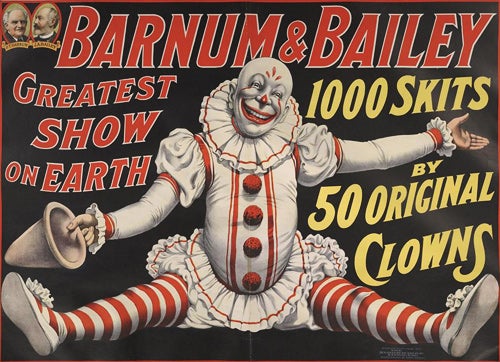
In the Journal of American Folklore, Lucile Hoerr Charles asks a question that doubles as a survey of clowns throughout the world: “What has the stage buffoon of the Chinese in common with the court fool of the Middle Ages in Europe; and with the stage fool in Elizabethan England, magnificently represented in Falstaff; and with the Badin in France, origin of our term badinage; and with the Spanish Bobo or Booby? How does the Narr and Hanswurst in Germany differ from the comic Vidusaka, stock character of the Hindu drama; or from the early Greek clowns depicted on Corinthian vases; or from the ancient Egyptian god Typhon, probably a deified clown, with his heavy, coarse face and protrusive tongue?”

Charles comes to the conclusion that clowns are always concerned “with something which is not quite proper; with something embarrassing, astonishing, shocking, but not too much so. This fact appears to be a constant at all times and in all places.” She illustrates how this role has served as a corrective to injustice and a pressure release for different cultures.
But in an article in the Smithsonian Magazine, Linda Rodriguez McRobbie points out another thing that clowns have in common: people find them scary. She cites a University of Sheffield survey of children between the ages of four and 16 that found that most of the children disliked and even feared images of clowns. While Coulrophobia, as the phobia of clowns is known, is not recognized by the American Psychiatric Association or the World Health Organization, Rodriguez McRobbie estimates that perhaps as much as two percent of the adult population fear clowns. Still, she concludes her piece with two studies that show that actual clowns have a beneficial effect on the health outcomes of sick children.
Our selection of images comes from the John and Mable Ringling Museum of Art Circus, Detroit Institute of Arts, Houston Community College, and Bodleian Library. To find more clown imagery, simply search the Artstor Digital Library for clown* (the asterisk can represent zero, one, or several characters, thus leading you to results for clown, clowns, clowning, etc.). We particularly recommend browsing through the John and Mable Ringling Museum of Art Circus Collection, which includes thousands of fascinating posters and historical photographs of clowns from the 19th century to the present.
Want to know more? Check out this JSTOR Daily article on the psychology behind clown fears.
What are you afraid of? Find something to keep you up at night with this list of our spookiest posts:


